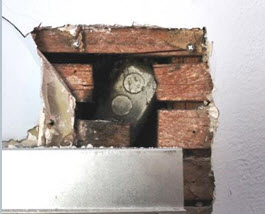The heat is on, but the circuit is off

By Jimmie Slemp, WECA Instructor and Lab Manager
An apprentice approached me with a very interesting situation. He said that his father-in-law has a gas wall furnace and when it's turned on, a few minutes later one of the lighting circuits would trip. That's interesting?
Note, most wall furnaces operate via a thermocouple that generates a small voltage for the thermostat and the gas solenoid, and they are more or less self-contained. They are not connected to a 120 volt electrical circuit, so why would the furnace cause a circuit to trip?
As we discussed the situation further, I found out there was some recent electrical work that was done in which the gas line was bonded to the cold water pipe.
This got me thinking. The circuit in question must somehow be making contact with a metallic surface on the furnace and up to this point it had not been a problem, or had it? This was probably a very dangerous situation. Whatever was happening between the furnace and the lighting circuit was probably energizing all metallic surfaces of the furnace, but because the furnace was not properly bonded, the circuit breaker was not tripping. This could have created a serious shock hazard - luckily (probably due to the fact the furnace was hot) no one touched the energized furnace and a grounded object at the same time.
In this case with the circuit breaker tripping, it actually was a good thing. So what's causing the circuit breaker to trip only when the furnace was on? I guess it is time for some troubleshooting.
So we isolated the circuit in question (removed the hot from the circuit breaker and the neutral from the neutral bar) and put it on a digital multi meter. With the furnace off we were getting a very high resistance to ground of approximately 2 Megs. However, after turning on the furnace and allowing it to warm up, the resistance fell to 0.2 ohms - basically a direct ground fault.
Another observation was that occasionally you could see a blue spark in the upper corner of the furnace when the circuit breaker tripped. The house was older and had a lathe and plaster finish so there was a little reluctance to start opening up the wall, but now with the meter confirming our diagnosis, we had little choice but to open the wall-and there it was!

A concealed metal handy box tucked above the furnace. Why was this box buried in the wall?! Who knows but it doesn't really serve any purpose if the wiring was no longer needed. It should have been removed, especially since it was so close to a heat source.
So, as relieved as we were to have found the problem, we quickly found this was not the only buried secret. As we tried to remove the conductors we found another handy box buried in the wall. Once we removed both boxes, we were able to re-feed the light switch that was adjacent to the furnace (but far enough away from the direct heat) and reconnect the circuit.
Mystery solved. This was a good example of two code violations with the potential of electrical shock and structural fire. The National Electric Code is very specific but for a good reason--in its purest form, the NEC Code is about your safety and the safety of others.